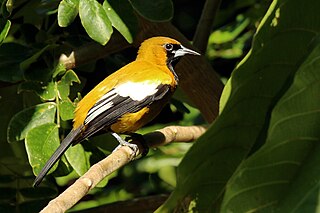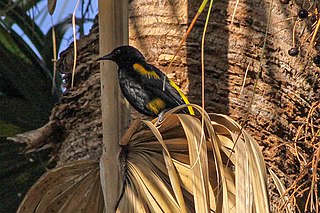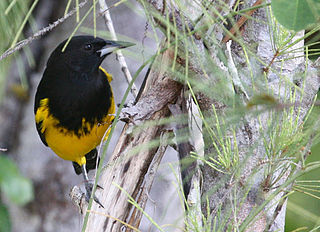
The Altamira oriole is a New World oriole. The bird is widespread in subtropical lowlands of the Mexican Gulf Coast and northern Central America, the Pacific coast and inland. They have since spread to southern Texas, but this was not until 1939.

New World orioles are a group of birds in the genus Icterus of the blackbird family. Unrelated to Old World orioles of the family Oriolidae, they are strikingly similar in size, diet, behavior, and strongly contrasting plumage. As a result, the two have been given the same vernacular name.

Audubon's oriole, formerly known as the black-headed oriole, is a New World passerine inhabiting the forests and thickets of southeastern Texas and the Mexican coast. It is the only species to have a black hood and yellow body. It is divided into four subspecies and two allopatric breeding ranges. The westernmost range extends from Nayarit south to southern Oaxaca, whereas the eastern range stretches from the lower Rio Grande valley to northern Querétaro. The most common in the western range are the subspecies I. g. dickeyae and I. g. nayaritensis; I. g. graduacauda and I. g. audubonii can be found in the eastern range. Like most Central American birds, it is not a migratory species and does not display significant sexual dimorphism. DNA analysis of the ND2 and cyt-b genes strongly suggests that I. graduacauda is most closely related to I. chrysater, the yellow-backed oriole. It is a member of the genus Icterus and therefore should not be confused with the Old World orioles.

The white-headed vanga is a species of bird in the family Vangidae. It is monotypic within the genus Artamella. It is endemic to Madagascar, where its natural habitats are subtropical or tropical dry forest, subtropical or tropical moist lowland forest, and subtropical or tropical moist montane forest.

The black-backed oriole is a species of bird in the family Icteridae. It is endemic to Mexico. Its natural habitats are subtropical or tropical moist lowland forest and subtropical or tropical moist montane forest, but it is also found in cities. It is one of the few species that can consume monarch butterflies due to evolving a tolerance to their natural poison.

The orange oriole is a species of bird in the family Icteridae. It is found in the Yucatán Peninsula and far northern Belize. The male has a bright orange hood and a black bib. Its natural habitats are subtropical or tropical dry forests and heavily degraded former forest.

The orange-crowned oriole is a species of bird in the family Icteridae. It is found in eastern Panama, Colombia and Venezuela.

The Martinique oriole is a species of bird in the family Icteridae. It is endemic to Martinique, French West Indies. Martinique is a part of the Lesser Antilles, and is located in the Eastern Caribbean.

The epaulet oriole is a species of bird in the family Icteridae. The moriche oriole, formerly considered a distinct species is now placed herein as a subspecies. The variable oriole,, was formerly considered conspecific, but has recently been split by the SACC.

The white-edged oriole is a species of bird in the family Icteridae. It is found in Ecuador and Peru.

The Jamaican oriole is a species of bird in the family Icteridae.

The bar-winged oriole is a species of bird in the family Icteridae. It is found in El Salvador, Guatemala, Honduras, and Mexico.

The spot-breasted oriole is a species of bird in the family Icteridae.

The black-vented oriole is a species of bird in the family Icteridae. It is found in El Salvador, Guatemala, Honduras, Mexico, Nicaragua, and the United States.

The Timor oriole is a species of bird in the family Oriolidae. It is endemic to the Lesser Sundas, where it is found on Timor, Rote and Semau Islands. Its natural habitats are subtropical or tropical dry forests and subtropical or tropical mangrove forests.

The silver oriole is a species of bird in the family Oriolidae. It breeds in southern China and winters in mainland Southeast Asia.

The Hispaniolan oriole is a species of bird in the family Icteridae. It is endemic to the Caribbean island of Hispaniola.

The Cuban oriole is a species of songbird in the family Icteridae. It is endemic to Cuba.

The Bahama oriole is a species of songbird in the New World blackbird family Icteridae. It is endemic to the Bahamas, and listed as endangered by the IUCN Red List.

The Puerto Rican oriole is a species of bird in the family Icteridae, and genus Icterus or New World blackbirds. This species is a part of a subgroup of orioles that includes the North American orchard oriole, Icterus spurius, and the hooded oriole, Icterus cucullatus.





















